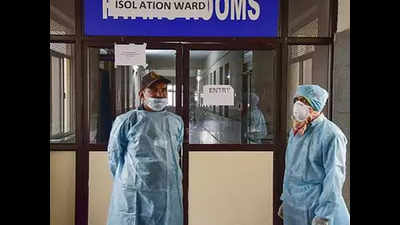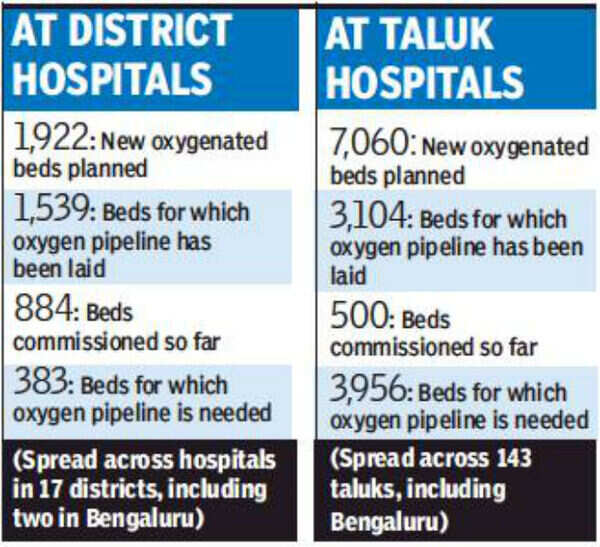- News
- City News
- bengaluru News
- Karnataka: District, taluk hospitals to get 4,339 oxygen beds
Trending
This story is from August 10, 2020
Karnataka: District, taluk hospitals to get 4,339 oxygen beds
ealising the increasing need for oxygenated beds to tackle Covid-19, the Karnataka government is adding 4,339 oxygen beds in district and taluk hospitals in the next three weeks.

Representative image
BENGALURU: Realising the increasing need for oxygenated beds to tackle Covid-19, the Karnataka government is adding 4,339 oxygen beds in district and taluk hospitals in the next three weeks.
With this, the state government would have nearly 9,000 such beds after the outbreak of Covid-19.

Some 1,244 oxygenated beds were already available at various district hospitals.Experts told TOI the beds will address the shortage and enhance Karnataka’s medical infrastructure in the long run.
4,600 beds fitted with medical gas pipeline systems
Of these, MGPLS has been added to 4,643 beds, while the remaining will be added in the next fortnight. Of the new beds with MGPLS, 1,384, including 500 at taluk hospitals, have been commissioned.
“The remaining will be commissioned in a phased manner depending on the demand, but the idea is to have the capacity to treat all the people requiring oxygen,” one official said. An expert said not more than 10% of the total number of active cases would require such beds on any given day. Going by this assessment, which puts 10% as the upper limit, some 7,700 patients in the worst-case scenario would have needed oxygen on August 8. Given that most patients would be in Bengaluru, the state also has the luxury of private hospitals with oxygen beds.
Apart from this, IAS officer Tushar Girinath had earlier told TOI that all the government medical college hospitals and private hospitals have been told to add this capacity.
Another epidemiologist working with the government said that the fact that people will not need to come to places like Bengaluru or the regional headquarters will mean more lives will be saved.
If you look at the districtwise data, 93% of districts in Karnataka have more than 1,000 cases, while 20% of the districts have more than 5,000 cases. “The fact that most of this burden can be handled at the district level would come as a huge relief for both patients and the authorities,” Babu added.
With this, the state government would have nearly 9,000 such beds after the outbreak of Covid-19.

Some 1,244 oxygenated beds were already available at various district hospitals.Experts told TOI the beds will address the shortage and enhance Karnataka’s medical infrastructure in the long run.
Documents reviewed by TOI show the government had planned to provide medical gas pipeline systems (MGPLS) to 8,982 beds across 143 taluk hospitals and 17 district hospitals in 16 districts. Two hospitals in Bengaluru will get 255 such beds.
4,600 beds fitted with medical gas pipeline systems
Of these, MGPLS has been added to 4,643 beds, while the remaining will be added in the next fortnight. Of the new beds with MGPLS, 1,384, including 500 at taluk hospitals, have been commissioned.
“The remaining will be commissioned in a phased manner depending on the demand, but the idea is to have the capacity to treat all the people requiring oxygen,” one official said. An expert said not more than 10% of the total number of active cases would require such beds on any given day. Going by this assessment, which puts 10% as the upper limit, some 7,700 patients in the worst-case scenario would have needed oxygen on August 8. Given that most patients would be in Bengaluru, the state also has the luxury of private hospitals with oxygen beds.
Apart from this, IAS officer Tushar Girinath had earlier told TOI that all the government medical college hospitals and private hospitals have been told to add this capacity.
Another epidemiologist working with the government said that the fact that people will not need to come to places like Bengaluru or the regional headquarters will mean more lives will be saved.
If you look at the districtwise data, 93% of districts in Karnataka have more than 1,000 cases, while 20% of the districts have more than 5,000 cases. “The fact that most of this burden can be handled at the district level would come as a huge relief for both patients and the authorities,” Babu added.
End of Article
FOLLOW US ON SOCIAL MEDIA










